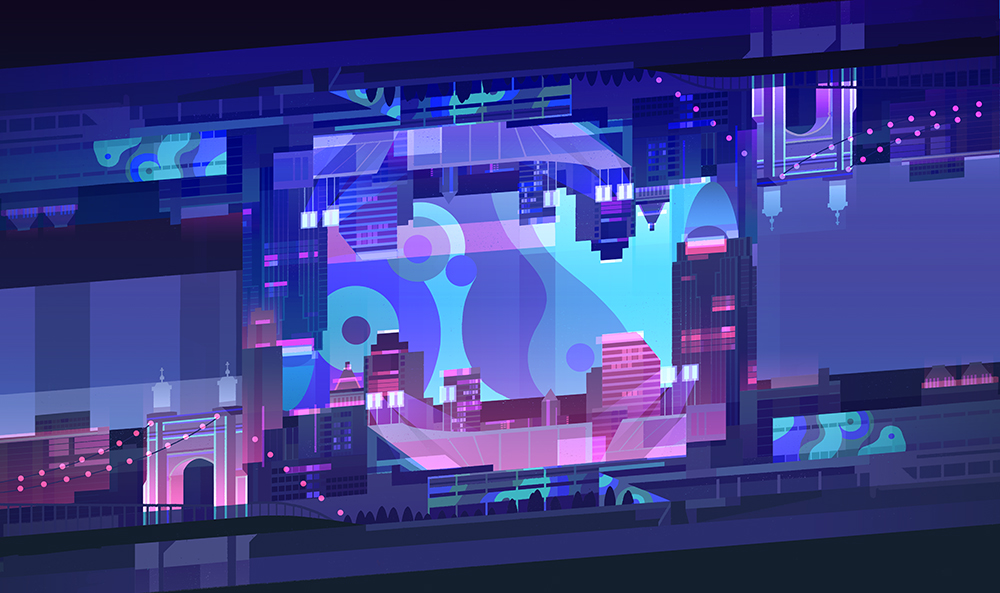
Illustration by Mark Boardman represented by meiklejohn.co.uk
The people of the future city are united and enlightened,” reads the first line of the Blink manifesto. The message? Cincinnati does not live in the past; it’s a future city. If that weren’t true, would an estimated 1 million people—possibly the largest gathering in city history—have flocked to the inaugural Blink light-based art festival in 2017? People literally dropped their guard, put aside differences, and walked confidently, even joyfully, down city streets and alleyways. Screw Mark Twain.
They did it “for art,” says Dan Reynolds, one of several creative minds behind the event. Those minds promise to thrill and delight us once again with works by local and international light projection and mural artists when Blink returns October 10–13.
But it’s more than a tech-savvy, mesmerizing experience of light and sound, says Andrew Salzbrun, another brain behind Blink. His Agar promotions company calls itself “the red substance in a petri dish that’s used to grow culture.” Blink, Salzbrun says, is an attitude. It champions inclusion while valuing the individual and the collective. Organizers often heard people ask what Blink was supposed to be about, so Salzbrun and Reynolds wrote a manifesto. A manifesto for a future city. “We took that as our marching orders to just be this future city,” Reynolds says. “Quit saying we aspire to be it. Just be it.”
“In the Blink of an eye their hearts and minds glow with the radiance of transcendent knowing,” the manifesto continues. “Knowing the light of a thousand tomorrows of opportunity and hope. Knowing the light that shines from their hearts is all that was ever needed to stay the darkness of ignorance and poverty.”
That’s all to say, Blink is free for a reason. Anyone who wants to come should come, organizers say. No tickets are required. Participants are just asked to have an open mind, a good attitude, and avoid parking under Fountain Square again. (Traffic disaster of 2017.)
Blink starts as a blank slate and takes on a life of its own, organizers say. The “magic” lies in the open calls for artists, performers, parade participants, and volunteers, says Steve McGowan, whose company Brave Berlin (co-owned by Reynolds) serves as creative director this year. “In their proposals and in their art pieces,” McGowan says, “messages come out.”
Two years ago, that included an illustrated documentary on the history of King Records projected onto a wall behind St. Francis Xavier Church between sets by local musicians playing King classics. It manifested itself in impromptu dance parties under a giant disco ball near Findlay Market and in a tribute to civil rights heroes that shone onto the National Underground Railroad Freedom Center.
The first glimpse of Blink came at Lumenocity, the city’s initial taste of light map projection on Music Hall. Lumenocity was supposed to be a one-off event in 2013, a welcome to Cincinnati Symphony Orchestra’s incoming music director, Louis Langrée. Somewhat unexpectedly, though, it was a hit. People packed Washington Park each night, filling stoops of boarded up buildings when the park reached capacity. That part of Over-the-Rhine was then still one of the most dangerous locales in the city, but a diverse crowd came together and enjoyed a unique art experience in the neighborhood where riots had erupted in 2001. It felt like progress.
Lumenocity ran its course, and the leadership of The Carol Ann and Ralph V. Haile Jr./U.S. Bank Foundation—Lumenocity and Blink’s founding partner—turned to the creative minds at Brave Berlin, Agar, and ArtWorks and asked, “What next?”
“Not here they said. Not in our shining future city,” the manifesto reads. “They work and play and draw the light from one another until it outshines the sun. The light inside revealed in all. The only light that matters.”
“We aren’t a perfect city,” says Tamara Harkavy, who founded ArtWorks in 1996. She’s right, of course. More than a quarter of Cincinnati residents live in poverty. That’s less than $12,490 in annual income in a single-person household and less than $25,750 for a four-person household. Cincinnati also has an alarmingly high rate of child lead poisoning and opioid addiction, and gun violence plagues our streets. “But we are a city that looks to the future,” Harkavy says, “and I believe artists solve problems.”
Blink offers a platform for voices such as Saya Woolfalk, an artist of Asian and African-American heritage who uses her transnational background to explore the future of racial and cultural cross-pollination. She designed a mural that will be illuminated for Blink.
The light show boosts Cincinnati’s economy—restaurants throughout downtown and OTR reported being packed throughout the Blink weekend two years ago. Every participating artist gets paid. “The creative class that’s making the city home right now, most of them don’t remember when we were a fly-over city,” McGowan says. “This is the only city they’ve known, and they love it.”
A city that celebrates unity and individuality, diversity and culture. A city that eyes its problems and thinks of creative ways to fix them.
“Together they shine with celebration, laughter, and labor shared for all the world to see,” the manifesto concludes. “And in the Blink of an eye, their radiance is undeniable.”




Facebook Comments